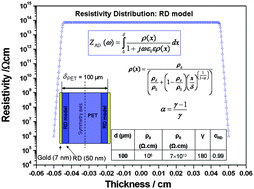Electrical impedance spectroscopy of a PET chip sandwiched between two disk electrodes: understanding the contribution of the polymer/electrode interface
Abstract
This work is devoted to the understanding of the dielectric impedance response of a semi-crystalline polyethylene terephthalate (PET) membrane sandwiched between two disk electrodes under alternate voltage excitation in the frequency range between 1 MHz and 25 mHz. Experimental results obtained for various PET thicknesses (36, 50 and 100 μm) highlighted the influence of the contact resistance at the electrode/polymer interface. For a better understanding of the PET/electrode interface behaviour, the experiments were compared with simulations performed for three different descriptions: the direct use of electrical equivalent circuits, an analytical model accounting for a power-law distribution of resistivity, and a numerical model (finite element simulations of the whole cell). The results highlight that the resistivity distribution obtained using the power-law model provided an appropriate description of the system in the frequency range investigated while the use of the CPE model is only consistent for low-frequencies (below 1 Hz).


 Please wait while we load your content...
Please wait while we load your content...